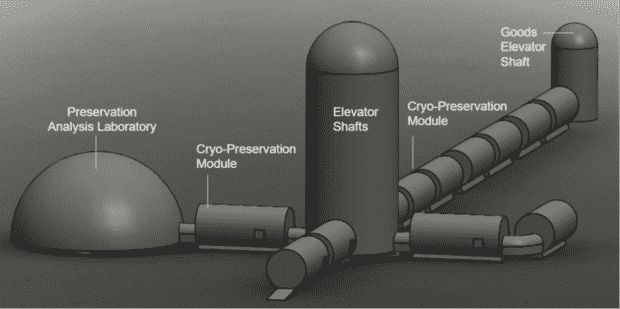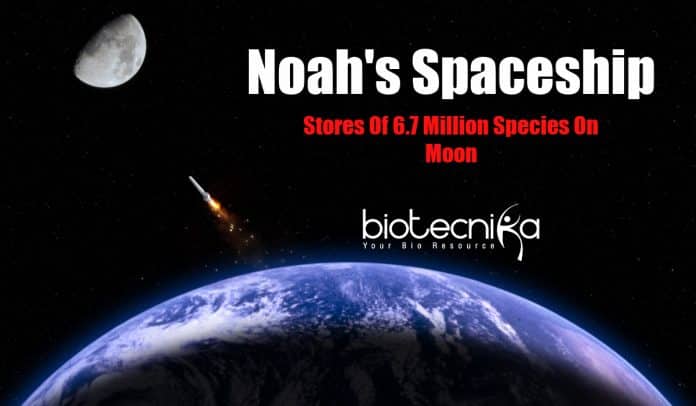Solar-Powered Lunar Noah’s Ark: Preserving DNA On Moon
Researchers are drawing ideas from Noah’Ark in a modern lunar concept that they propose as a global insurance policy. They intend to deliver a similar ark to the Moon, packed with 335 million egg and sperm samples, in case of Earth’s doom.
The uncertain state of Earth has always concerned researchers. An alternative place to Earth for permanent settling has been the ultimate motive ever since space studies started. The scientific community’s eternal thought on establishing habitation on the Moon, Earth’s natural satellite, and other bodies of the solar system, has been under exploration for a while. Even though the Moon compared to other planets may not be a perfect spot for perpetual colonization, it could play a crucial role as a space for storing our indispensable assets.
Rather than taking two kinds from every animal, the solar-driven lunar ark would compose of cryogenically stored frozen egg, sperm, spore, and seed samples from about 6.7 million species on Earth. Jekan Thanga, a researcher from the University of Arizona (UA), and a team of his pupils proposed the idea in a research paper presented for the IEEE Aerospace Conference last week.
Thanga, professor of
Aerospace & Mechanical Engineering, UA College of Engineering stated in a press release that Earth is obviously a volatile planet. It was a narrow escape with the supervolcanic eruption of Toba around 75,000 years back, which resulted in a 1,000-year cooling time and, based on few reports it orients with a computed fall in anthropologic heterogeneity. Since human civilization has a massive footprint, supposedly if it got destroyed, that could leave a drastic series of negative effects on the leftover planet remains.Thanga pinpointed climate variations as the major issue, particularly since it contributes to the increasing sea levels. A large-scale nuclear war and a deadly global pandemic are two other main probabilities that Doomsday Clock scientists cite for the tragic catastrophes.
Doomsday vault or Svalbard Seedbank, Spitsbergen island, Arctic Sea presently stores countless plant seeds to assure perpetual biodiversity on Earth. The distinct seed vault holds around 992,000 specimens-each having about 500 seeds. However, Thanga’s group thinks that holding such invaluable samples on Earth is extremely risky.
Fortunately, the Moon which is situated 238,855 miles away poses no such problems.
Lava tubes for storing samples
Developing the ark would entail sending out 6.7 million specimens to the Moon in several payloads, later storing them in a cellar under the surface, where it would remain safe.
The concept is to shelter the ark inside a lava tube network- around 200 of which were found under the surface of the Moon in 2013. These lava tubes were formed when streams of underground lava created huge caverns of over 300 feet diameter and 80-100 meters depth billions of years ago.

These hollow tubes have remained still for 3-4 billion years, and researchers recommend that they could offer much-required safeguarding from temperature changes, meteors, or solar radiation on the surface.
Even though the Moon is inhospitable for humans, its harsh attributes make it a wonderful location to hold samples that has to stay undisturbed in a very cold environment for centuries at once, they claimed.
Developing a modern Lunar Noah’s Ark
According to few preliminary calculations, Thanga mentioned that sending around 50 samples from each of 6.7 million species- rounding to 335 million samples-might need around 250 rocket launches. That is around six times more than the launches required to build the International Space Station, which is 40 rocket launches.
He added that this is not insanely huge. They were a little bit shocked about that.
The group’s proposal for the ark consists of Petri dishes stored in cryogenic preservation units, lift shafts down to the facility, and solar panels on the surface of the Moon for electricity.
The stem cells should be cooled to -320° Fahrenheit and the seeds to -292° Fahrenheit. For instance, Pfizer’s COVID-19 vaccine is stored at -94° Fahrenheit.
Since these extremely low temperatures could freeze metal, the group has presented a kind of drifting rack from a cryo-colled superconductor product and driven by quantum levitation with a strong magnet.
Thanga explained that it resembles as if they are secured in position using strings, however, it is invisible strings. When the cryogenic temperature is attained, unusual things occur. Few things resemble magic however are based on experimented and laboratory checked physics concepts at the edge of our knowledge.
They additionally recommend that robotics steer the unit on magnetic tracks. Clearly, extensive study is still required, including the consequences of the absence of gravity on seeds a clear plan for interaction with Earth.
Álvaro Díaz-Flores Caminero, doctoral student, UA, guiding the thermal assessment for the project discussed that the astonishing thing about projects similar to this is that they make you feel as if we are reaching near to becoming a space community, and to a near future where mankind will have settlement on Mars & Moon. Projects which are multidisciplinary are difficult because of their complexity, however, he thinks that the same complexity is the beauty of the project.
Lunar Noah’s Ark, Solar-powered, lunar ark, Solar-powered lunar ark, Solar-powered lunar ark



























